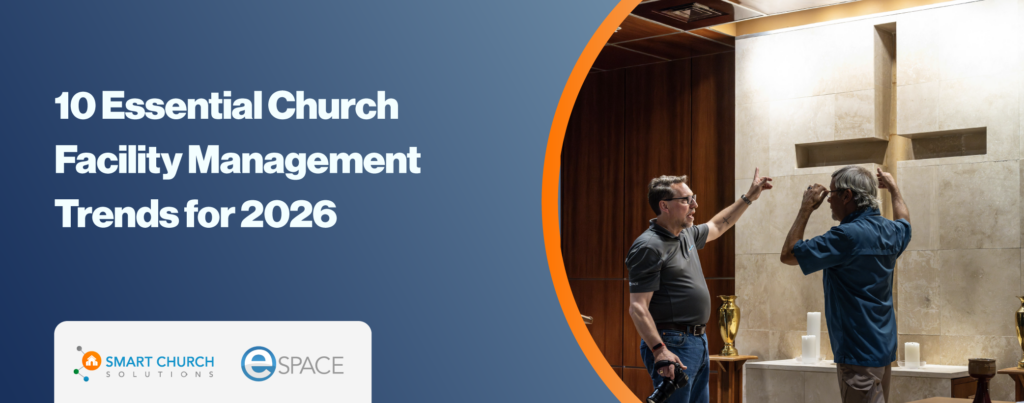If your church doesn’t have a dedicated team—paid or volunteer—focused on maintaining the facility, you’re likely missing a key piece of good stewardship.
Building a church maintenance ministry (also called a church facility ministry) isn’t just about tools and tasks—it’s about mindset, mission, and sustainable care of what God has entrusted to your congregation.
This guide outlines the purpose, process, and people needed to get started.
Why a Church Maintenance Ministry Is Essential
Churches rely heavily on their facilities to do ministry—whether it’s hosting worship services, providing childcare, running food pantries, or offering community events. Without proper maintenance, these spaces deteriorate, and the ministry suffers.
A facility maintenance ministry helps:
- Preserve the value and safety of your campus
- Support church programs and services
- Extend the lifespan of equipment and infrastructure
- Engage volunteers with practical skills
- Demonstrate responsible stewardship
Step 1: Start With Vision, Purpose, and Values
Before forming a team, establish the why behind your ministry.
- Vision: What do you want this ministry to achieve? How does it support your church’s mission?
- Purpose: Define why this ministry exists. Is it to create safe spaces, extend equipment life, or support events?
- Values: These drive how your team operates. Examples might include: “We finish what we start,” “We show up on time,” or “We do ordinary tasks with extraordinary care.”
Pro Tip: Look for Scripture on stewardship (Luke 16:10, 1 Peter 4:10) and include it in your ministry’s foundation.
Don’t Build It Alone: Collaborate to Get Buy-In
Creating a facility ministry in isolation often leads to burnout or lack of adoption. Instead:
- Gather a small team of staff, board members, or skilled volunteers.
- Host a kickoff meeting to brainstorm purpose, scope, and values.
Draft the vision and mission together—this creates shared ownership.
Avoid falling into what some call the “Simple Church trap,” where churches borrow phrases like “Love God, Love People, Serve the World” simply because they were used as an example in the book Simple Church. That slogan was meant to illustrate one church’s unique expression of its mission—not a template for every ministry. Take the time to develop language and a ministry culture that genuinely reflects your church.
Step 2: Define the Scope of Work
Clarity is everything. Without it, you’ll either under-plan or overcommit. Decide what your ministry will handle:
- Preventive maintenance (HVAC, plumbing, lighting, etc.)
- Landscaping and groundskeeping
- Event setup and takedown
- Repairs and upgrades
- Vendor management
- Emergency response
- Safety inspections (fire extinguishers, AEDs, emergency lighting)
Your church may choose to engage volunteers, hire part-time help, or outsource certain tasks—define this upfront.
Use SOPs to Empower and Equip
Standard Operating Procedures (SOPs) are not red tape—they’re tools for consistency, training, and excellence.
They help:
- Volunteers know exactly how to do a task correctly.
- New team members onboard faster.
- Leaders delegate with confidence.
Example SOPs could include:
- How to test emergency lighting
- How to sanitize children’s rooms after services
- How to report broken or unsafe equipment
Pro Tip: Use AI tools or templates from eSPACE University to quickly draft SOPs for your most common tasks.
Step 3: Identify Leadership and Responsibilities
A ministry without leadership quickly becomes disorganized. Assign a point person or facility manager who will:
- Own the vision
- Coordinate volunteers or staff
- Liaise with church leadership
- Manage the work order system
- Ensure training and accountability
Then, map out roles and responsibilities for everyone involved. Use SOPs (Standard Operating Procedures) for routine tasks to keep things consistent—especially with volunteers.
Step 4: Use a Work Order and Task Management System
Even the best-intentioned ministries fall apart without a way to track work. A system like eSPACE allows your team to:
- Submit and manage work orders
- Assign and track tasks
- View maintenance schedules
- Monitor asset health
- Centralize vendor and facility data
This level of organization ensures your team is proactive, not reactive.
Step 5: Recruit and Train the Right People
Whether paid or volunteer, your people need the right mindset and the right tools. Start with:
- Orientation to the ministry’s vision and expectations
- Clear task assignments with documented procedures
- Ongoing training (eSPACE University can help here!)
- Volunteer appreciation and spiritual encouragement
Facility volunteers are often hidden heroes. Pray for them, encourage them, and give them the same care you would any other ministry team.
Step 6: Build a Sustainable Plan
Don’t overpromise. Set goals based on what you can realistically accomplish with your current people, time, and budget. Then grow from there. Review outcomes regularly, revisit your mission annually, and stay aligned with your church’s broader vision.
The Mindset Shift: From Task List to Ministry Calling
Too often, facilities staff or volunteers are seen as the “maintenance crew” rather than ministers. This perspective shift is foundational. Cleaning a floor or fixing a leak isn’t just upkeep—it’s preparation for someone to meet God in a distraction-free environment.
“Am I cleaning this room just to check a box, or am I preparing a space for someone to hear the gospel?”
Cultivating this mindset among your team changes everything—from morale to the quality of work to volunteer retention.
Aligning with the Church’s Broader Mission
Your facility ministry should not operate in a silo. Its purpose must complement the vision, mission, and values of your church. For example:
- If your church values hospitality, your facility team ensures every guest restroom is spotless.
- If your mission involves serving your community, your buildings must be clean, functional, and welcoming.
Invite senior leadership to review your ministry’s charter. When alignment happens, the facility ministry earns trust and support from every level of leadership.
Final Thought: This Is Ministry—Not Just Maintenance
Cleaning a bathroom. Replacing an air filter. Fixing a broken pew. They’re not glamorous tasks, but they are kingdom work. When you frame your facility team as a ministry—not just a to-do list—you invite people into a deeper sense of purpose and a tangible expression of stewardship.
Imagine this:
- A guest walks into your sanctuary and feels peace—not distraction—because the space is clean, functional, and welcoming.
- A children’s room is sanitized and well-maintained, giving parents peace of mind.
- A volunteer feels seen, prayed for, and spiritually nourished while also changing HVAC filters or repairing a water line.
That’s when you know your facility ministry is doing more than maintenance—it’s building the church.
Ready to Get Started?
eSPACE helps hundreds of churches nationwide launch, organize, and manage effective facility maintenance ministries. Our software is purpose-built for church facilities, and our resources (like eSPACE University) help train your team from day one.








